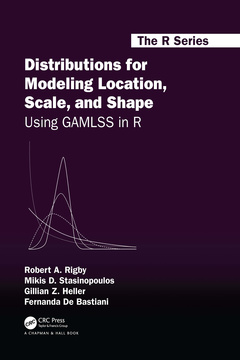Description
Distributions for Modeling Location, Scale, and Shape
Using GAMLSS in R
Chapman & Hall/CRC The R Series
Authors: Rigby Robert A., Stasinopoulos Mikis D., Heller Gillian Z., De Bastiani Fernanda
Language: English
Subjects for Distributions for Modeling Location, Scale, and Shape:
Keywords
GAMLSS Model; Poisson Inverse Gaussian; GAMLSS family; Cumulative Distribution Function; shape; Generalized Tobit Model; scale; Location Shift Parameter; mixed distributions; Tweedie Distributions; modeling location; GAMLSS; Global Deviance; Worm Plots; Package Gamlss; Data Set; Generalized Inverse Gaussian; Inverse Gaussian; Power Exponential Distribution; Beta Binomial Distribution; Distribution Regression Models; Head Circumference; Kurtosis Parameter; Burr III; Skewness Parameter; Binomial Denominator; Burr XII; GAIC; GB2 Distribution; Inflated Distributions
Approximative price 71.13 €
In Print (Delivery period: 14 days).
Add to cartPublication date: 06-2021
· 17.8x25.4 cm · Paperback
178.41 €
In Print (Delivery period: 14 days).
Add to cartPublication date: 09-2019
· 17.8x25.4 cm · Hardback
Description
/li>Contents
/li>Biography
/li>
This is a book about statistical distributions, their properties, and their application to modelling the dependence of the location, scale, and shape of the distribution of a response variable on explanatory variables. It will be especially useful to applied statisticians and data scientists in a wide range of application areas, and also to those interested in the theoretical properties of distributions. This book follows the earlier book ?Flexible Regression and Smoothing: Using GAMLSS in R?, [Stasinopoulos et al., 2017], which focused on the GAMLSS model and software. GAMLSS (the Generalized Additive Model for Location, Scale, and Shape, [Rigby and Stasinopoulos, 2005]), is a regression framework in which the response variable can have any parametric distribution and all the distribution parameters can be modelled as linear or smooth functions of explanatory variables. The current book focuses on distributions and their application.
Key features:
- Describes over 100 distributions, (implemented in the GAMLSS packages in R), including continuous, discrete and mixed distributions.
- Comprehensive summary tables of the properties of the distributions.
- Discusses properties of distributions, including skewness, kurtosis, robustness and an important classification of tail heaviness.
- Includes mixed distributions which are continuous distributions with additional specific values with point probabilities.
- Includes many real data examples, with R code integrated in the text for ease of understanding and replication.
- Supplemented by the gamlss website.
This book will be useful for applied statisticians and data scientists in selecting a distribution for a univariate response variable and modelling its dependence on explanatory variables, and to those interested in the properties of distributions.
Part I: Parametric distributions and the GAMLSS family of distributions. Chapter 1 Types of distributions. Chapter 2 Properties of distributions. Chapter 3 The GAMLSS Family of Distributions. Chapter 4 Continuous distributions on (−1,1). Chapter 5 Continuous distributions on (0, ∞). Chapter 6 Continuous distributions on (0, 1). Chapter 7 Discrete distributions for count data Chapter. 8 Binomial type distributions Chapter. 9 Mixed distributions. Part II: Advanced Topics. Chapter 10 Maximum likelihood Chapter. 11 Robustness of parameter estimation to outlier Chapter. 12 Methods of generating Chapter. 13 Discussion of skewness. Chapter 14 Discussion of Kurtosis Chapter. 15 Skewness and kurtosis comparisons of continuous distributions. Chapter 16 Heaviness of tails of continuous. Part III: Reference Guide. Chapter 17 Continuous distributions on (−∞,∞). Chapter 18 Continuous distributions on (0, ∞). Chapter 19 Mixed distributions on 0 to ∞, including 0. Chapter 20 Continuous and mixed distributions on [0, 1]. Chapter 21 Count data. Chapter 22 Count data distributions. Chapter 23 Binomial type distributions and multinomial distributions.
Robert Rigby was researching in Statistics at London Metropolitan University for over 30 years specializing in distributions and advanced regression and smoothing models (for supervised learning). He is one of the two original developers of GAMLSS models. He is currently a freelance consultant.
Mikis Stasinopoulos is a statistician. He has a considerable experience in applied statistics and he is one of the two creators of GAMLSS. He worked as the director of STORM, the statistics and mathematics research centre of London Metropolitan University and now he is working as an independent statistical consultant.
Gillian Heller is Professor of Statistics at Macquarie University, Sydney. Her research interests are mainly in flexible regression models for heavy-tailed count data, with applications in biostatistics and insurance.
Fernanda De Bastiani is a permanent lecturer in the Statistics Department at Universidade Federal de Pernambuco, Brazil. Her research interests are mainly in flexible regression models, spatial data analysis and influential diagnostics in regression models.




